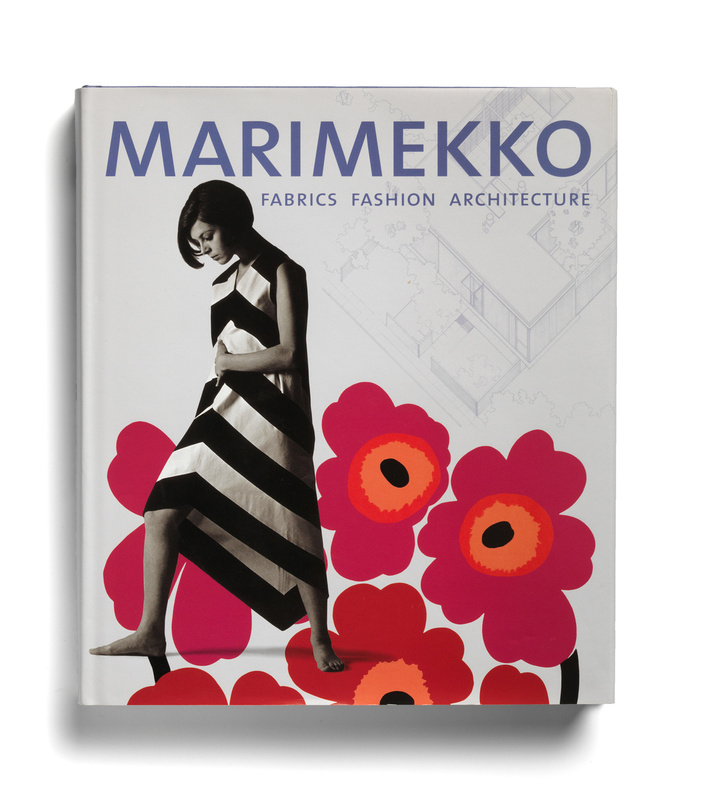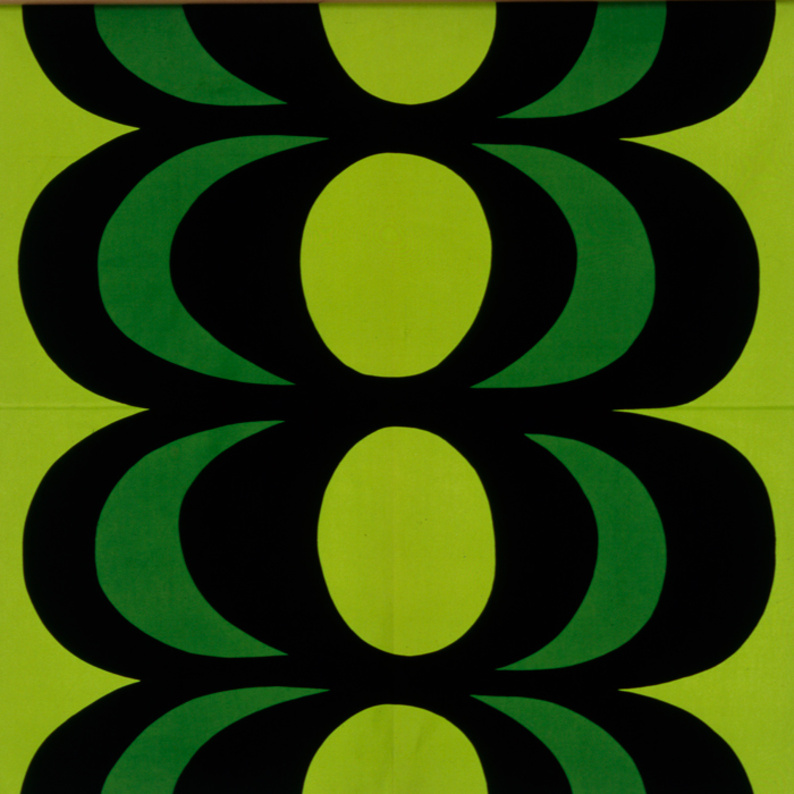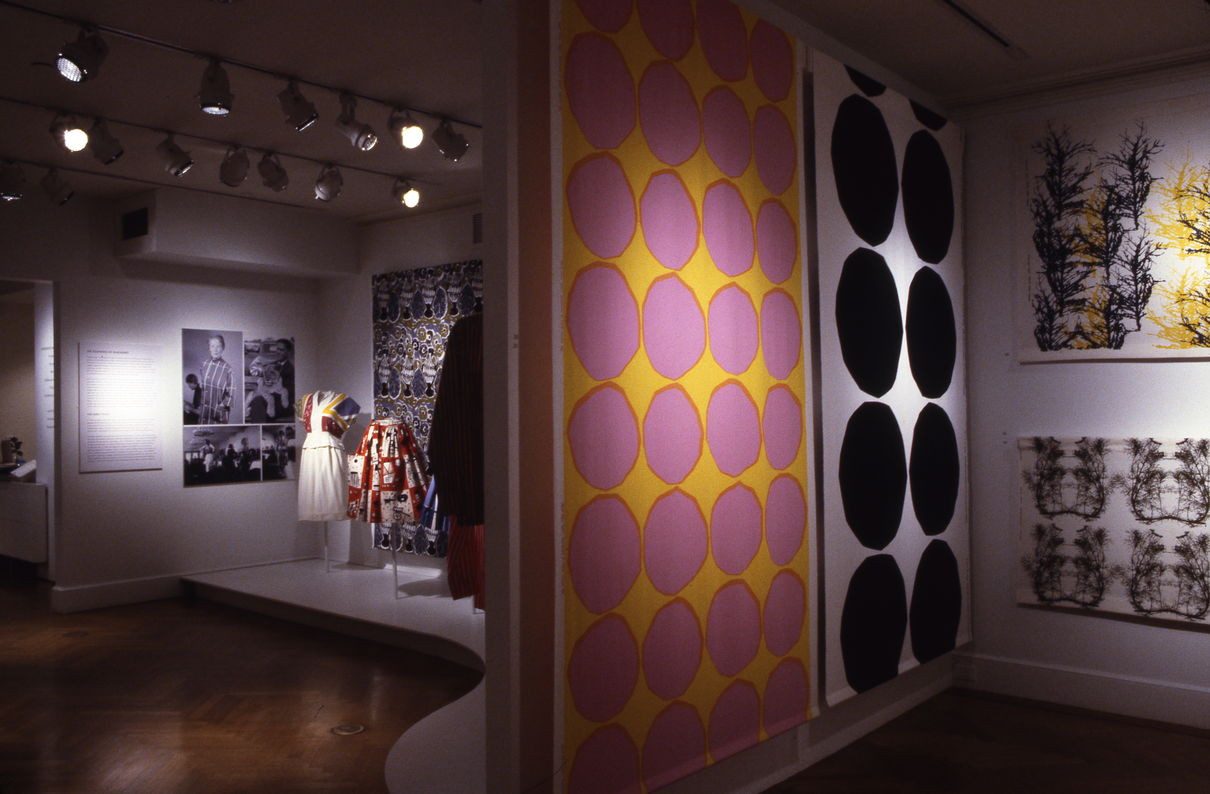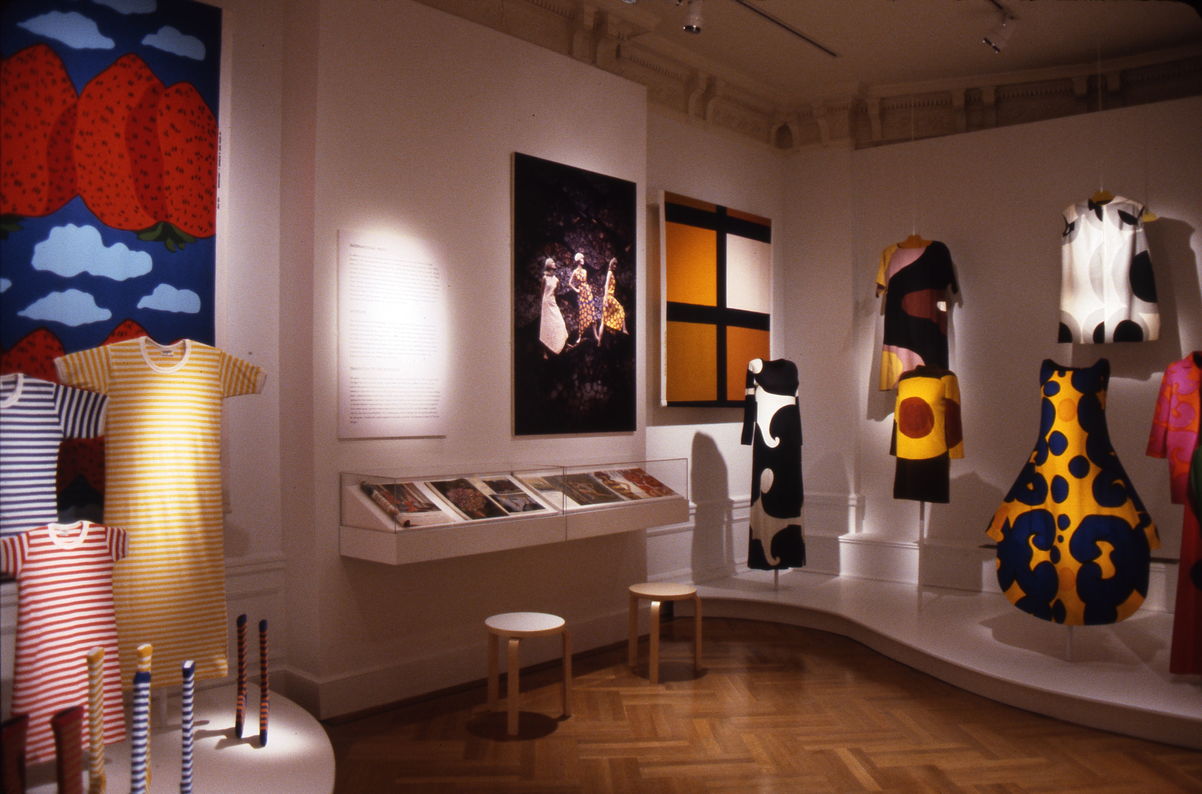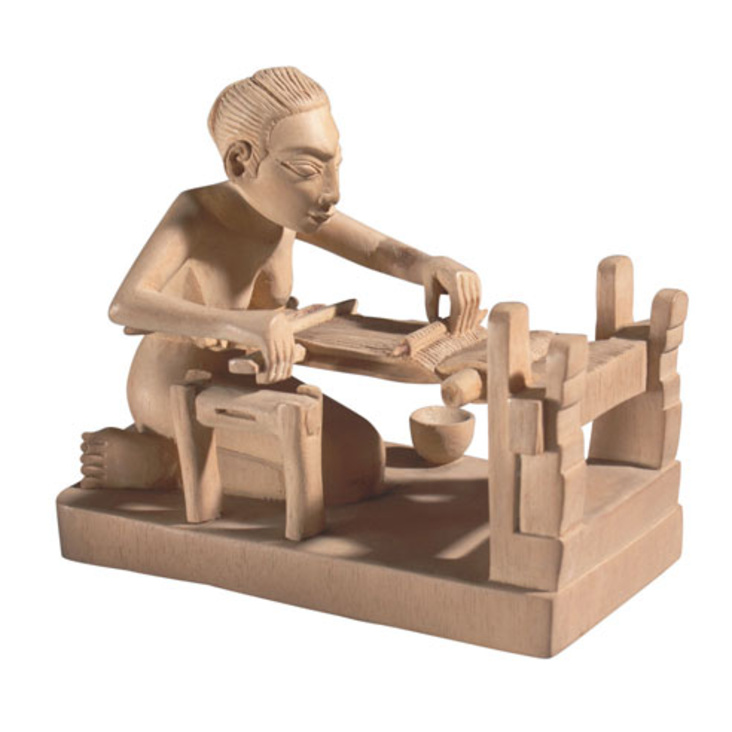Marimekko: Fabrics, Fashion, Architecture examined the design company’s remarkable history from its early years through the height of its international success during the 1960s and mid-1970s and up to today.
Composed of more than 150 examples of fabrics, fashion clothing, accessories, and architecture, the Marimekko exhibition conveyed the unique modern vision of the company’s founder and artistic director, Armi Ratia, and illuminated the work of Marimekko’s outstanding designers and how they revolutionized modern printed fabrics and fashion. The Finnish Museum of Art and Design in Helsinki, which houses the most important collection of Marimekko in the world and is the recipient of the Marimekko archive, was the principal lender to the exhibition. Other lenders included private and public collections both in Finland and in the United States.
Marimekko is, without doubt, one of the great success stories in the history of 20th-century design. Founded in 1951 by the visionary textile designer Armi Ratia and her husband Viljo, the company grew from a small textile-printing firm into an international phenomenon and gave Finland a definitive presence on the world fashion stage. The exuberant colors and accessible cuts of Marimekko clothing as well as the bold patterns of their printed textiles became a national symbol of a new optimism and equality in postwar Finland and introduced a highly original vocabulary to the fields of fashion and home design. Even more than sparking a revolution in printed textiles, Marimekko also introduced a groundbreaking marketing concept, proposing a definition of fashion that embraced the entire home environment and set the precedent for a lifestyle brand.
The name Marimekko derives from the vernacular Finnish form of the girl’s name “Mary” and mekko, which means “dress.” The combination of the modern and the traditional proved invaluable to the company’s success in Finland and internationally.
Marimekko grew out of a small company called Printex, which was acquired by Viljo Ratia in 1949. Ratia expanded Printex, which had focused primarily on the production of oilcloth, into the textile-printing business. It was his wife, Armi (1912–79), who, as art director, built Marimekko into a purveyor and advocate of a highly distinct and fashionable lifestyle concept. Armi hired young artists with a fresh vision and encouraged them to experiment. She gave them a free hand to respond to new artistic and social currents.
The results were spirited, nontraditional patterns with vivid colors that expressed an informal, contemporary, accessible way of life. Marimekko’s clothing, in particular, with its clean, unisex lines and free, loose-fitting style, conveyed a utopian feel of sexual equality and evoked the character of the 1960s. Marimekko was the first ready-to-wear fashion house to create a fashion sensation comparable to the renowned European haute couture houses.
When Marimekko introduced its first collection in Helsinki in spring 1951, the radical new designs, hand-printed on crisp cotton, invigorated the audience. The successful premiere helped launch the company’s brand identity in Finland, though economic success was still a decade away. The first Marimekko store opened in Helsinki in 1953, a year after Finland cleared its war indemnity with the Soviet Union. The export business was launched in 1958 at the Stockholm sales exhibition. The American audience was introduced to Marimekko in the late 1950s through architect Benjamin Thompson’s Cambridge-based chain of stores, Design Research. The publicity from that, as well as the extensive press coverage of Jacqueline Kennedy’s purchase of Marimekko dresses; the opening of Marimekko lifestyle stores in the United States, Europe, Japan, and Australia; and exhibitions in Boston, Paris, Stuttgart, and New York brought the firm international recognition.
In the early 1960s, Ratia hired architect Aarno Ruusuvuori, whose work was considered Finland’s most ascetic. Ratia and Ruusuvuori collaborated to create various architectural projects. The Marimekko utopian community scheme, a comparatively unrecognized aspect of Marimekko that was of central importance to Ratia’s modern vision, was conceived as a village for 3,500 inhabitants, including Marimekko employees. In 1963 Ratia established the Marikylä Corporation with the intention of realizing Ruusuvuori’s vision of the village. The model house that was prefabricated at Bökars, the Marimekko company estate near Porvoo, a town located southeast of Helsinki, was described as a “minimum dwelling.” Numerous photographs taken of the house for advertising purposes reveal the primacy of the site in a thickly wooded forest and the colorful interiors, with prominent textiles hung from large windows. The press immediately identified with the project, describing it as Marimekko’s conquest of new architectural territory. In the end the ambitious scheme was never realized, due largely to economic factors and to the reluctance of employees to move permanently out of Helsinki to the countryside.
Ruusuvuori also designed an experimental sauna for Marimekko that was intended for the international market. The sauna, which, when Simo Rista photographed it overlooking the sea, became one of the iconic images of Finnish architecture, was also a prefabricated design that could be easily packaged and shipped. This concept was, in fact, in opposition to a refined version of the Finnish notion of a sauna built with vernacular materials according to vernacular traditions. Ruusuvuori’s sauna was another Marimekko idea that made a great impact when it was initiated, but never got beyond the prototype stage.
In 1967, Reijo Lahtinen from Ruusuvuori’s office designed Marimekko’s first printing factory in the industrial district of Verkkosaari in northeastern Helsinki. In 1973, a new factory, designed by Erkki Kairamo with Reijo Lahtinen, was built near the center of Helsinki in Herttoniemi; to this day this location continues to be the center of Marimekko corporate culture.
The first section of the exhibition explored the creation and rise of the Marimekko brand and its unique design philosophy. Included in this section were archival company documents, design drawings, fabrics, fashion, and photographs. It also examined how the Marimekko design philosophy has been expressed through the macrocosm of architecture with plans, scale models, and photographs of various projects.
The second section introduced the most important Marimekko designers and considered the key role played by women in creating the company’s successful lifestyle concept. Armi Ratia’s strategy for building a unique brand was to employ young, talented designers, many from the Institute of Industrial Arts in Helsinki, who were not trained in fashion design and thus not influenced by traditional precepts. The early Marimekko collections consisted of 24 designs, with each outfit having a specific name that reflected the “new look.” This tradition continues today. One of the first and most influential Marimekko designers, Maija Isola, was a textile artist and painter whose interior textiles boasted oversized geometric patterns and bright colors, two hallmarks of Marimekko designs. Her colleague, Vuokko Nurmesniemi, trained as a ceramic artist, was responsible for the Piccolo brushstroke pattern (1953) and the Everyboy shirts (1956), still among Marimekko’s bestselling products.
Another important designer represented in the exhibition was Annika Rimala, who originally trained as a graphic designer and created the Even Stripe cotton jersey T-shirt that dominated the jazz and rock festivals of the 1970s and became a symbol of the new unisex approach in the fashion industry. From the 1950s through the 1970s, artists such as Liisa Suvanto, Katsuji Wakisaka, Pentti Rinta, Fujiwo Ishimoto, Ristomatti Ratia (Armi Ratia’s son), and Marja Suna continued the revolution and gained international recognition. This section of the exhibition traced the stylistic development of these and other designers from the beginnings of Marimekko through today.
The third section of the exhibition explored the evolution of Marimekko from a company that provided fashion and fabrics for women to a company that created the whole living space. It presented Marimekko in use in everyday life. Marimekko’s most famous advertising campaigns were represented here, as was Design Research and its well-known shops in Cambridge, New York, and San Francisco. Armi Ratia’s association with Benjamin Thompson was of central importance to the realization of her design philosophy and to refining and disseminating her vision of modern life. Today there is a resurgence of interest in Marimekko in large part due to the corporate vision of its CEO, Kirsti Paakkanen.
The curator was Marianne Aav, an art historian and the director of the Finnish Museum of Art and Design, who also cocurated the highly successful exhibition Finnish Modern Design: Utopian Ideals and Everyday Realities, 1930–1997, which was held in 1998 at the BGC.
A fully illustrated catalogue, Marimekko: Fabrics, Fashion, Architecture, published by the BGC in collaboration with Yale University Press, accompanied the exhibition. It was the first comprehensive study of Marimekko, and the illustrations consist of new photographs, commissioned by the BGC, of fabric and fashion in the extensive Marimekko collection of the Finnish Museum of Art and Design, and period photographs. It includes essays by art and cultural historians, and a section of selected works in the exhibition organized by designer.












